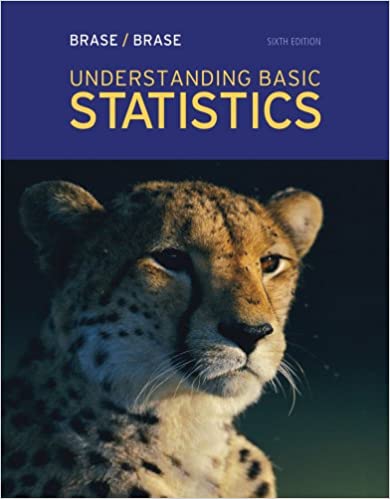
Understanding Basic Statistics 6th Edition by Charles Henry Brase,Corrinne Pellillo Brase
Edition 6ISBN: 978-1111827021
Understanding Basic Statistics 6th Edition by Charles Henry Brase,Corrinne Pellillo Brase
Edition 6ISBN: 978-1111827021 Exercise 159
Focus Problem: Impulse Buying Let x represent the dollar amount spent on supermarket impulse buying in a 10-minute (unplanned) shopping interval. Based on a Denver Post article, the mean of the x distribution is about $20 and the estimated standard deviation is about $7.
(a) Consider a random sample of n = 100 customers, each of whom has 10 minutes of unplanned shopping time in a supermarket. From the central limit theorem, what can you say about the probability distribution of
 , the average amount spent by these customers due to impulse buying What are the mean and standard deviation of the
, the average amount spent by these customers due to impulse buying What are the mean and standard deviation of the
 distribution Is it necessary to make any assumption about the x distribution Explain.
distribution Is it necessary to make any assumption about the x distribution Explain.
(b) What is the probability that
 is between $ 18 and $22
is between $ 18 and $22
(c) Let us assume that. x has a distribution that is approximately normal. What is the probability that x is between $ 18 and $22
(d) Interpretation: In part (b), we used
 , the average amount spent, computed for 100 customers. In part (c), we used x , the amount spent by only one customer. The answers to parts (b) and (c) are very different. Why would this happen In this example,
, the average amount spent, computed for 100 customers. In part (c), we used x , the amount spent by only one customer. The answers to parts (b) and (c) are very different. Why would this happen In this example,
 is a much more predictable or reliable statistic than x. Consider that almost all marketing strategies and sales pitches are designed for the average customer and not the individual customer. How does the central limit theorem tell us that the average customer is much more predictable than the individual customer
is a much more predictable or reliable statistic than x. Consider that almost all marketing strategies and sales pitches are designed for the average customer and not the individual customer. How does the central limit theorem tell us that the average customer is much more predictable than the individual customer
(a) Consider a random sample of n = 100 customers, each of whom has 10 minutes of unplanned shopping time in a supermarket. From the central limit theorem, what can you say about the probability distribution of
 , the average amount spent by these customers due to impulse buying What are the mean and standard deviation of the
, the average amount spent by these customers due to impulse buying What are the mean and standard deviation of the  distribution Is it necessary to make any assumption about the x distribution Explain.
distribution Is it necessary to make any assumption about the x distribution Explain.(b) What is the probability that
 is between $ 18 and $22
is between $ 18 and $22(c) Let us assume that. x has a distribution that is approximately normal. What is the probability that x is between $ 18 and $22
(d) Interpretation: In part (b), we used
 , the average amount spent, computed for 100 customers. In part (c), we used x , the amount spent by only one customer. The answers to parts (b) and (c) are very different. Why would this happen In this example,
, the average amount spent, computed for 100 customers. In part (c), we used x , the amount spent by only one customer. The answers to parts (b) and (c) are very different. Why would this happen In this example,  is a much more predictable or reliable statistic than x. Consider that almost all marketing strategies and sales pitches are designed for the average customer and not the individual customer. How does the central limit theorem tell us that the average customer is much more predictable than the individual customer
is a much more predictable or reliable statistic than x. Consider that almost all marketing strategies and sales pitches are designed for the average customer and not the individual customer. How does the central limit theorem tell us that the average customer is much more predictable than the individual customerExplanation
From the given information,
Let the rand...
Understanding Basic Statistics 6th Edition by Charles Henry Brase,Corrinne Pellillo Brase
Why don’t you like this exercise?
Other Minimum 8 character and maximum 255 character
Character 255


